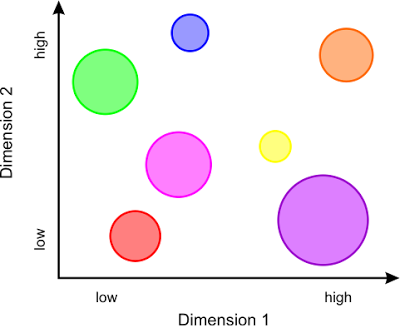
The innovation portfolio is an important instrument of innovation strategy which has direct and important consequences for innovation management. It is used to structure and visualise the current set of innovation projects in a company. Its primary goal is to ensure that a company's innovation activities are balanced; that it is neither over- nor under-invested in any particular strategically functional area of innovation.The most common structuring tool for an innovation portfolio is the well-known three-dimensional diagram shown above. Each innovation project in the company is denoted by a circle of a certain size at a specific coordinate in two-dimensional space. This gives three dimensions for characterising each project.
Some characteristics of innovation projects which are typically used are:
- Market uncertainty
- Technical uncertainty
- Sales volume
- Time to market
- Implementation costs
- Strategic potential
The innovation portfolio plays an important role in the final phase of idea evaluation. There, each idea is entered into the diagram, and it is determined how well it complements the already existing and planned projects. Ideas which compete with an already occupied location in the diagram may need to be postponed, or they may replace the existing project. On the other hand, ideas which fill a critical empty space in the diagram may well be assigned an increased priority as a result. The innovation portfolio also plays an important role at the very front of the front end of innovation, since - at least in a well-managed innovation process - gaps in the project space should automatically trigger ideation activities. These ideation tasks can be precisely directed towards the specific need that has been identified in the portfolio structure. Thus, instead of just looking for generic "ideas for new products", the innovation manager will be able to design his or her ideation activities to generate "ideas for platform products with a time to market of at least three years", for example. The latter task has - by virtue of its precision - a much higher chance of success.
This is one example of how a great deal of the fuzziness can be removed from the "fuzzy front end of innovation."
